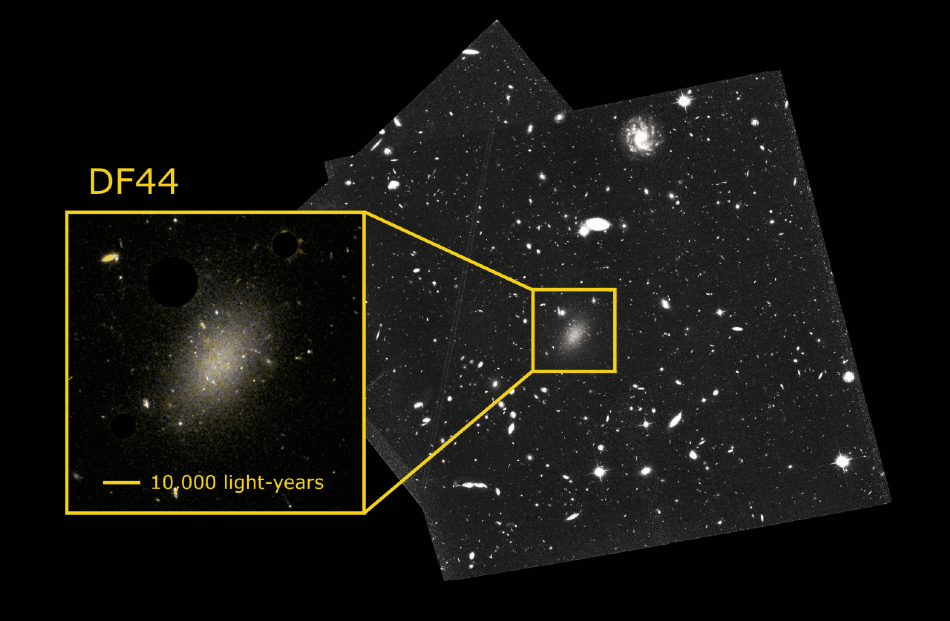Oct 14 2020
How galaxies form is hard to understand currently without the existence of an omnipresent yet enigmatic component called dark matter.
 Image and amplification (in color) of the ultra-diffuse galaxy Dragonfly 44 taken with the Hubble space telescope. Image Credit: Teymoor Saifollahi and NASA/HST.
Image and amplification (in color) of the ultra-diffuse galaxy Dragonfly 44 taken with the Hubble space telescope. Image Credit: Teymoor Saifollahi and NASA/HST.
Astronomers have quantified the amount of dark matter present around galaxies and have discovered that it ranges from 10 to 300 times the amount of visible matter. But the discovery of a highly scattered object, called Dragonfly 44, changed this perception. This galaxy was discovered to have 10,000 times more dark matter compared to the stars.
Astronomers were surprised by the finding and have taken efforts to find if this object is truly anomalous, or whether there was anything wrong in the analysis of the observations. They have now arrived at the solution.
Led by the Kapteyn Institute of the University of Groningen (the Netherlands), with contribution from the Instituto de Astrofísica de Canarias (IAC) and the University of La Laguna (ULL), an international group of researchers has discovered that the total number of globular clusters surrounding Dragonfly 44, and thus the dark matter content, is considerably less than previous findings. This indicates that the galaxy is neither anomalous nor unique.
The study findings were published recently in Monthly Notices of the Royal Astronomical Society (MNRAS).
The Dragonfly 44 galaxy was found as part of an in-depth survey of the Coma cluster, which includes several thousand galaxies. From the beginning, the galaxy has been regarded as incredible by scientists since the amount of dark matter they deduced was nearly equal to that in the Milky Way, the equivalent of a billion solar masses.
However, rather than including about a hundred thousand million stars, like the Milky Way, DF44 contains only a hundred million stars, fewer by a thousand times. This indicates that the quantity of dark matter was 10,000 times higher compared to its stars. In case this was true, it would have been an exclusive object, with nearly 100 times as much dark matter as that predicted from the number of its stars.
However, the researchers have performed an elaborate analysis of the system of globular clusters surrounding Dragonfly 44 and found that the total number of globular clusters is just 20. Moreover, they also identified that the total amount of dark matter is nearly 300 times that of the luminous matter, indicating that it is not much different from the normal value for galaxies of this kind.
The fact that in our work we found only 20 globular clusters, compared with the 80 previously claimed, reduces drastically the amount of dark matter which the galaxy is believed to contain. Moreover, with the number of globular clusters we found, the amount of dark matter in Dragonfly 44 is in agreement with what is expected for this type of galaxies. The ratio of visible to dark matter is no longer 1 in 10,000 but one in 300.
Ignacio Trujillo, Study Co-Author and Researcher, Instituto de Astrofísica de Canarias
“Dragonfly 44 has been an anomaly all these years that could not be explained with the existing galaxy formation models. Now we know that the previous results were wrong and that DF44 is not extraordinary. It is time to move on,” noted Teymoor Saifollahi, first author of the study and researcher at the Kapteyn Institute.
Our work shows that this galaxy is not so singular nor unexpected. That way the models of galaxy formation can explain it without the need for modification.
Michael A. Beasley, Study Co-Author and Researcher, Instituto de Astrofísica de Canarias
Beasley is also a specialist in globular clusters.
The total number of globular clusters corresponds to the total mass of a galaxy. Therefore, the amount of dark matter can be found by measuring the number of globular clusters, specifically if the amount of visible matter is only a small fraction of the total.
However, we don’t have a physical explanation for this relation between the total number of globular clusters and the total mass of the galaxy. This is purely observational knowledge. It could be that it has to do with the quantity of the original gas from which the stars, and the globular clusters themselves, have formed. The more dark matter there is in a galaxy, the more gas it contains.
Johan H. Knapen, Study Co-Author and Researcher, Instituto de Astrofísica de Canarias
Journal Reference:
Saifollahi, T., et al. (2020) The number of globular clusters around the iconic UDG DF44 is as expected for dwarf galaxies. Monthly Notices of the Royal Astronomical Society. doi.org/10.1093/mnras/staa3016.